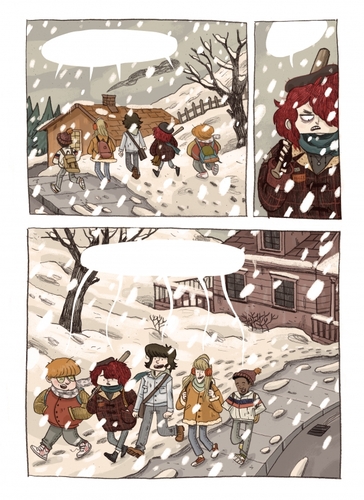BRATTLEBORO — When Andrea Fontana set out to write a coming-of-age graphic novel set in the 1980s, he decided it would take place in Brattleboro - a place where, oddly, the writer, essayist, and lover of film and comic books from Genova, Italy, has never set foot.
But with the electronic help of dozens of members of a local Facebook group, Clara and the Shadows, which will be published in Italy next year, will include some touches of local authenticity.
For the setting of the story, which will follow a group of youngsters navigating their way into their teen years, Fontana wanted certain features for storyline and mood.
“I needed a place that would enhance the autumn colors and when it snowed in winter, Vermont was perfect from this point of view,” he said via a text-message interview.
From there, Fontana wanted to narrow down a region with “a forest, a river, a lake, and above all a small city, not a metropolis.”
So the writer got down to business.
He scoured the Vermont terrain using Google Maps. From the comfort of his home, where he explored Vermont vicariously from the air and along the state's roads and highways using the web mapping service's satellite and multiple perspectives of still photography along at least some of the state's roads and byways, Fontana eventually found his perfect location: Brattleboro.
In May, Fontana joined the Brattleboro, Vermont Facebook group seeking counsel from its more than 5,300 members about the town and the setting.
There, he found dozens of group members immediately and enthusiastically willing to help him with details and nuances of the place and time.
Many offered nostalgic suggestions about the era's teen hangouts. Others posted old photos. Jerry Carbone, retired director of Brooks Memorial Library, posted links to a database of Rutland Herald stories from the Reagan years.
Fontana characterized the response as “amazing.”
“Many people [wrote] me to give info about the main places, some history, famous people who lived in Brattleboro,” he said. “For example, an artist sent me some images of his illustration of Brattleboro.”
That artist was printmaker William Hays.
Putney artist Deborah Lazar connected Fontana with a “very, very kind” actor and filmmaker Moriah Martel, a Brattleboro expatriate who shared with him her short film, Hometown Tarot.
As a result, the setting became much more than coordinates on a map.
For example, “I discovered the lights on the Hotel Brooks during Christmas,” Fontana said, noting a favorite scene that takes place atop the local historic landmark.
“Everything has been designed to emphasize the beauty of some places in Brattleboro,” he said.
A universal experience
Fontana, born in 1981, said his original focus was on paying homage to the 1980s as a time and a place, much as the Netflix series Stranger Things tapped into the nostalgia of the era.
But the writer - a comics critic whose love of the genre has moved him to start writing sequential art - says the book became much deeper, a result of immersing himself in a setting far away and long ago.
The main themes of Clara and the Shadows will “concern the fears of facing the difficulties of life at a crucial time like adolescence,” Fontana said. “Bullying, fear of loneliness, abandonment, emotional shortage are all shadows that risk marking our path.”
The book will be appropriate for children, yet will resonate with adults as well, he said.
“I also know that everyone personally experiences what I consider the most important phase of our life: childhood.”
For Fontana, a film critic for Segnocinema, an Italian magazine of film criticism, the genres of the past three to four decades resonate, particularly the punk movement.
He also cited a “particular form” of U.S. filmmaking of the 1980s “that talked with young people”: movies like The Goonies, The Karate Kid, Stand By Me, Ladyhawke, and Back to the Future, as well as the films of John Hughes, which “spoke in a sincere and direct way to the hearts of teenagers.”
Interpreting the atmosphere
Like most everything else about this project, Fontana connected with Claudia Petrazzi online after encountering her work on social media.
Petrazzi, based in Arezzo, Italy, has been drawing since childhood and, after graduating from art school there, has become a prolific illustrator, cartoonist, and stop-motion animator whose online portfolio ranges from the sweet animals of children's books to edgy and macabre.
Like Fontana, Petrazzi, who also spoke with The Commons via text message, has had no direct connection with the area but has been using Google Maps and visual reference to create a world for the story.
Petrazzi “immediately [fell] in love with [the] landscapes and colors” of Brattleboro, noting that she wants the artwork to reflect “the beauty that Vermont offers in the autumn season.”
“My [scripts] leave a lot of freedom to the artists I work with, and this has always paid off,” Fontana said in praising his collaborator.
“Claudia in particular managed to perfectly interpret the atmosphere I had for some scenes and in some cases she managed to add something more to the structure of the page or to small details, facial expressions, nuances that are often fundamental,” he said.
Petrazzi first breaks down the story into rough pencil art, then creates final art with soft, dark graphite pencil. She then colors the pages digitally.
Both Fontana and Petrazzi, who now have somewhat of an intimate relationship with southern Vermont, said that they would love to actually visit Brattleboro.
The writer has high hopes that the publisher, Editrice il Castoro S.r.l., will sell the United States publishing rights and that the book will be translated and be published in this country.
And if that happens, he and Petrazzi plan to “present the book right there, in Brattleboro,” Fontana said.
To be continued.
